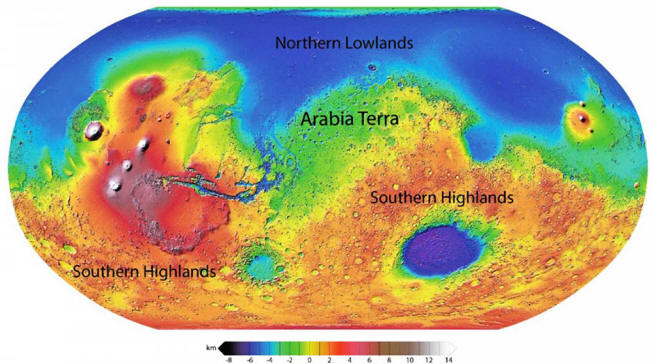|

by
Bex Caygill
August 24,
2016
from
UCL Website

Perspective view of Aram Dorsum,
an
inverted channel on Mars and candidate landing site
for the
ExoMars rover
(credit: NASA/JPL/MSSS)
Fossilized
rivers suggest warm, wet ancient Mars
Extensive systems of fossilized riverbeds have been discovered on an
ancient region of the Martian surface, supporting the idea that the
now cold and dry 'Red' Planet had a warm and wet climate about four
billion years ago, according to UCL-led research.
The study (Extensive
Noachian fluvial systems in Arabia Terra - Implications for early
Martian climate), published in Geology and funded
by the Science & Technology Facilities Council and the UK
Space Agency, identified over 17,000km of former river channels
on a northern plain called Arabia Terra, providing further evidence
of water once flowing on Mars.
"Climate models of early Mars predict rain in Arabia Terra and until
now there was little geological evidence on the surface to support
this theory.
This led some to believe that Mars was never warm and
wet but was a largely frozen planet, covered in ice-sheets and
glaciers.
We've now found evidence of extensive river systems in the
area which supports the idea that Mars was warm and wet, providing a
more favorable environment for life than a cold, dry planet,"
explained lead author, Joel Davis (UCL Earth Sciences).
Since the 1970s, scientists have identified valleys and channels on
Mars which they think were carved out and eroded by rain and surface
runoff, just like on Earth.
Similar structures had not been seen on
Arabia Terra until the team
analyzed high resolution imagery from
NASA's Mars Reconnaissance Orbiter (MRO) spacecraft.

Topographic map of Mars.
Arabia Terra is an ancient region that connects
the southern highlands and the northern lowlands
(credit: NASA/JPL/MOLA Science Team)
The new study examined images covering an area roughly the size of
Brazil at a much higher resolution than was previously possible -
six meters per pixel compared to 100 meters per pixel.
While a few
valleys were identified, the team revealed the existence of many
systems of fossilized riverbeds which are visible as inverted
channels spread across the Arabia Terra plain.
The inverted channels are similar to those found elsewhere on Mars
and Earth.
They are made of sand and gravel deposited by a river and
when the river becomes dry, the channels are left upstanding as the
surrounding material erodes.
On Earth,
inverted channels often occur
in dry, desert environments like Oman, Egypt, or Utah, where erosion
rates are low - in most other environments, the channels are worn
away before they can become inverted.

Aerial view of inverted channels on the Earth,
south-west of the Green River, Utah
(credit: Rebecca Williams,
Planetary Science Institute, Arizona, USA)
"The networks of inverted channels in Arabia Terra are about 30m
high and up to 1-2 km wide, so we think they are probably the remains
of giant rivers that flowed billions of years ago.
Arabia Terra was
essentially one massive flood plain bordering the highlands and
lowlands of Mars.
We think the rivers were active 3.9-3.7 billion
years ago, but gradually dried up before being rapidly buried and
protected for billions of years, potentially preserving any ancient
biological material that might have been present," added Joel Davis.
"These ancient Martian flood plains would be great places to explore
to search for evidence of past life.
In fact, one of these inverted
channels called Aram Dorsum is a candidate landing site for the
European Space Agency's
ExoMars Rover mission, which will launch in
2020," said Dr Matthew Balme, Senior Lecturer at The Open University
and co-author of the study.
The researchers now plan on studying the inverted channels in
greater detail, using higher-resolution data from MRO's
HiRISE
camera.
|




